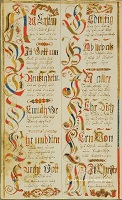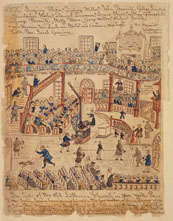
Religious broadsides, house blessings (Haus-segen) and purely pictorial works all received the fraktur treatment. As early as 1772, the Ephrata Cloister brother and sister calligraphers were turning out the “Goldene ABC,” an inspirational work. Other communities followed with their own versions. This example is by Schwenkfelder Susanna Heebner. The cloister (and other) presses produced a holy labyrinth (Geistliche Irrgarten) and house blessing, competing with hand-drawn versions of the same subjects.

Some artists associated with the Pennsylvania German fraktur tradition pushed the boundary between it and the purely pictorial mode. These pieces are larger than presentation fraktur and the subject matter often is outside the typical fraktur tradition. Depiction of animals, still lifes, portraits, history and landscape are common. York, PA native Lewis Miller (1796 – 1866) compiled a chronicle of everyday life that includes over two thousand drawings.
2,246 thoughts on “Pictorial and Religious Fraktur”
Comments are closed.